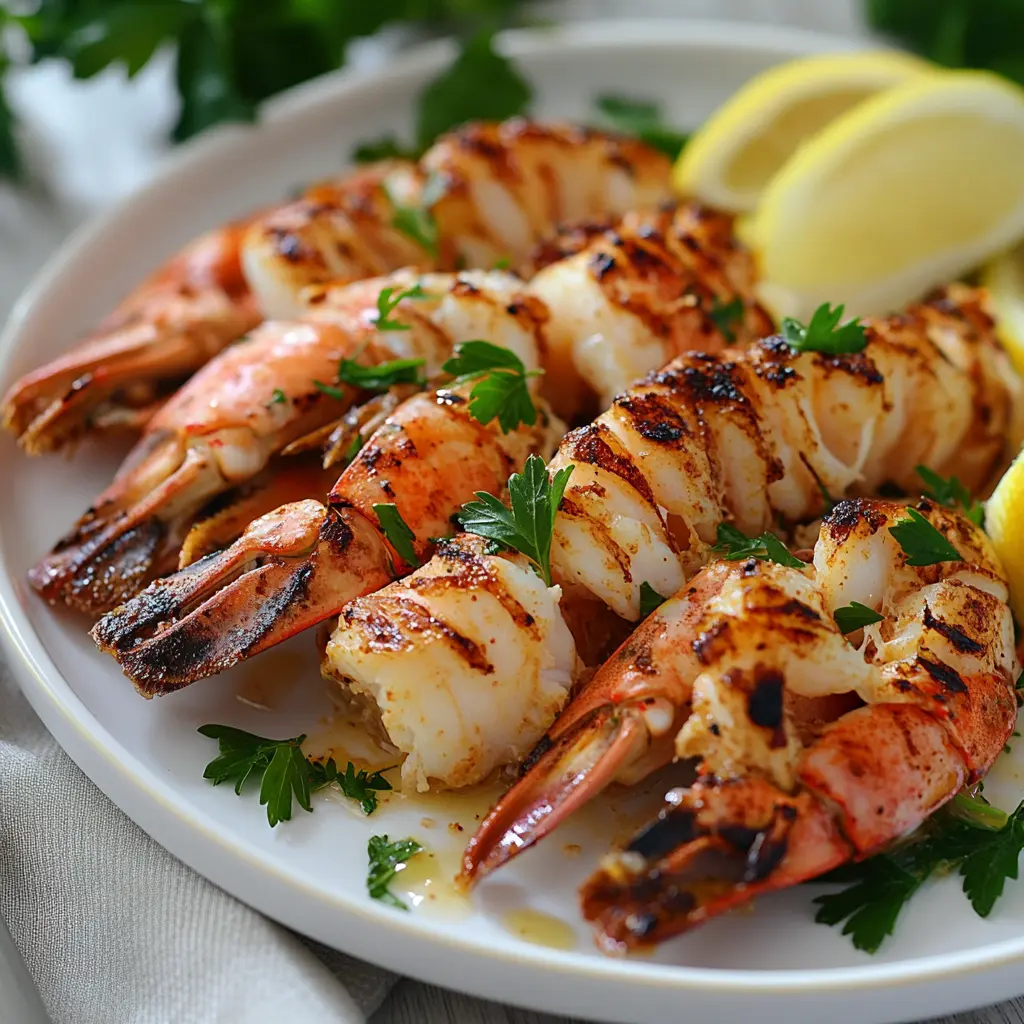Introduction
Langoustine tails are a celebrated seafood delicacy. Cherished for their sweet, delicate flavor and succulent texture. Sourced from cold, pristine waters, these tails offer an exquisite taste experience that has earned them a prominent place in fine dining and home kitchens alike. Known scientifically as Nephrops norvegicus, langoustines are often compared to lobsters, yet they are smaller and boast a unique flavor profile that sets them apart.
In this article, we’ll explore everything you need to know about langoustine tails, from understanding their origins and health benefits to mastering the art of preparing and cooking them. Whether you’re a seafood enthusiast or a culinary novice, this guide will equip you with all the insights needed to savor langoustine tails at their best.https://royalesrecipes.com/what-is-langoustine-a-guide-to-the-seafood-delicacy/
Understanding Langoustines ” Langoustine Tails “
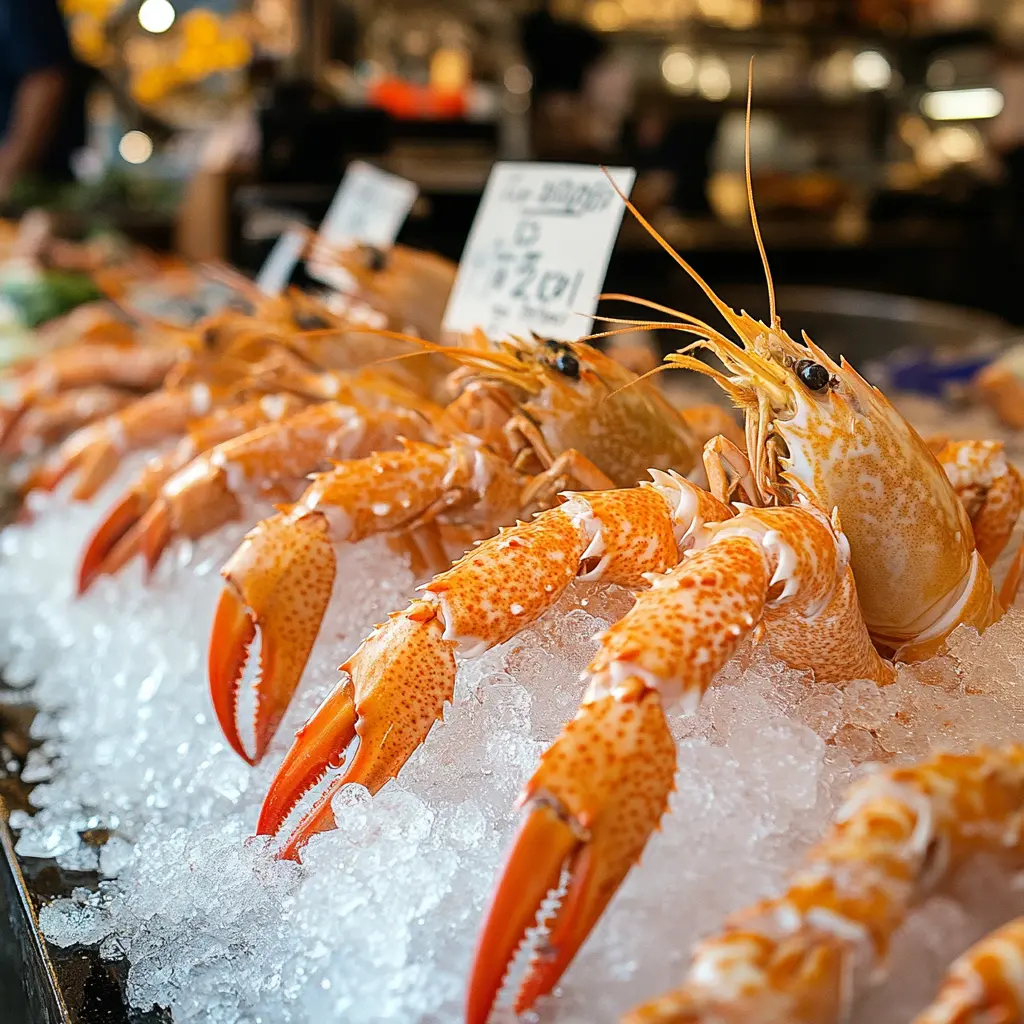
Origin and Habitat
Langoustines, also known as Norway lobsters, are native to the cold waters of the North Atlantic Ocean. These crustaceans thrive in muddy seabeds, typically found at depths ranging from 20 to 800 meters. Their natural habitat stretches from the Mediterranean Sea to the northern waters near Iceland and Norway. Unlike larger lobsters, langoustines prefer cooler temperatures and are more commonly harvested in specific regions known for their sustainable fishing practices.
Appearance and Biology
Langoustines are small, slender lobsters with a vibrant orange-pink shell. Their tails, the prized part of their anatomy, are relatively meaty and encased in a segmented shell. Langoustines have long, slender claws and ten legs, making them visually distinct from other crustaceans. Their size generally ranges from 10 to 20 centimeters, depending on their age and habitat.
Their biology plays a significant role in their unique taste. Langoustines feed on small mollusks and worms, which contribute to the sweet and briny flavor of their meat. Additionally, the cold-water habitat slows their growth rate, resulting in tender, flavorful flesh.
Nutritional Benefits
Langoustine tails are not only delicious but also incredibly nutritious. They are an excellent source of high-quality protein, making them a great option for building and repairing muscle tissue. Additionally, they are low in fat and calories, which makes them suitable for those seeking a lean source of protein.
Key nutrients found in langoustine tails include:
- Omega-3 fatty acids: Essential for heart health and reducing inflammation.
- Vitamins B12 and E: Support nervous system function and provide antioxidant protection.
- Minerals: High in potassium, magnesium, and zinc, promoting overall wellness.
With these benefits, langoustine tails are a smart choice for a balanced and nutritious diet.
Choosing the Best Langoustine Tails
How to Select Fresh Langoustine Tails
Selecting high-quality langoustine tails is the first step to creating a memorable dish. Fresh langoustine tails should have a firm texture, a light pinkish-orange color, and a clean, briny scent. Here’s a guide to ensure you choose the best:
- Appearance: Look for tails with a glossy sheen and no signs of discoloration or drying. Avoid tails with black spots or an overly dull appearance, as these are indicators of spoilage.
- Smell: Fresh langoustines should smell like the ocean. A strong, fishy odor is a warning sign that the seafood is past its prime.
- Texture: The flesh should feel firm and springy when pressed gently. Soft or mushy tails are a sign of degradation.
If purchasing frozen langoustine tails, ensure they are individually quick frozen (IQF) and stored in vacuum-sealed packaging. This method preserves their texture and flavor.https://www.greatbritishchefs.com/collections/langoustine-recipes
Signs of Quality
Understanding the grading system for langoustines can help you make an informed choice. They are often categorized by size, with larger tails being more desirable due to their meatiness. Look for labels indicating:
- Premium or Grade A: The highest quality, with intact shells and minimal imperfections.
- Sustainably Sourced: Labels such as MSC (Marine Stewardship Council) certification indicate ethical fishing practices.
When buying from a fish market, don’t hesitate to ask the seller about the catch date and the source of the langoustines.
Storage Tips
Proper storage is essential to maintaining the freshness and quality of langoustine tails. Follow these storage tips to keep your seafood at its best:
- Refrigeration: If you plan to use the tails within 24-48 hours, store them in the coldest part of your refrigerator at a temperature below 4°C (40°F). Place them in an airtight container or wrap them in plastic wrap to prevent exposure to air.
- Freezing: For longer storage, freeze the tails immediately after purchase. Ensure they are placed in a vacuum-sealed bag to prevent freezer burn. Frozen langoustine tails can last up to three months.
- Thawing: When ready to cook, thaw frozen tails in the refrigerator overnight or submerge them in cold water for a quicker method. Avoid using hot water, as this can degrade the texture of the meat.
These guidelines will ensure you have the freshest langoustine tails ready for your culinary creations.
Preparing Langoustine Tails
Cleaning and Deveining
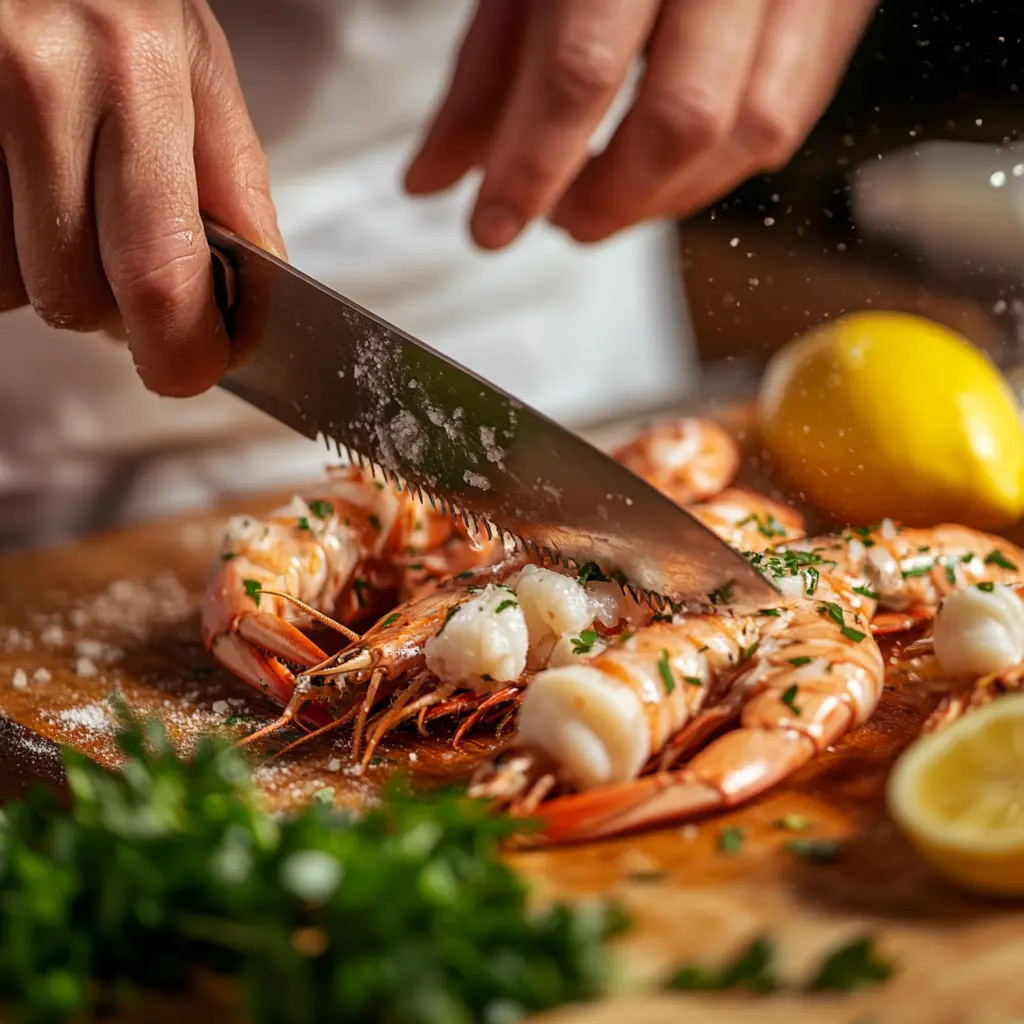
Before cooking, proper cleaning and deveining of langoustine tails are crucial for both taste and hygiene. Here’s how to prepare them:
- Remove the Shell: Hold the langoustine tail firmly in one hand and use the other to gently twist and pull off the shell. If the shell is stubborn, you can use kitchen scissors to cut along its length.
- Remove the Vein: Similar to shrimp, langoustines have a dark vein running along their back, which is the digestive tract. Use a small paring knife to make a shallow incision along the top of the tail and lift the vein out with the tip of the knife or a toothpick.
- Rinse and Pat Dry: Rinse the cleaned tails under cold running water and pat them dry with a paper towel to ensure a good sear or proper absorption of marinades during cooking.
Tools Required
Preparing langoustine tails is easier with the right tools. Here’s a list of essentials:
- Kitchen Scissors: For cutting through shells effortlessly.
- Paring Knife: For deveining and making precise cuts.
- Seafood Cracker (Optional): Useful for breaking hard shells if the tails are left intact.
- Cutting Board: A stable surface for cleaning and prepping.
Investing in these tools will streamline the preparation process and ensure you handle the delicate tails with care.
Prepping for Cooking
Preparation varies depending on the cooking method. Here are some general guidelines:
- Marinating: For grilling or sautéing, marinate the tails in olive oil, lemon juice, garlic, and herbs like parsley or thyme. Allow them to sit for 20-30 minutes to absorb the flavors.
- Brining: For boiling or steaming, consider a light brine solution of water, salt, and sugar to enhance the natural sweetness of the meat.
- Butterflied Tails: To create an elegant presentation for grilling or baking, butterfly the tails by making a lengthwise cut down the middle without slicing all the way through. Spread them open gently.
These preparation steps will elevate the flavor and presentation of your dish, making the langoustine tails the star of the meal.
Cooking Langoustine Tails
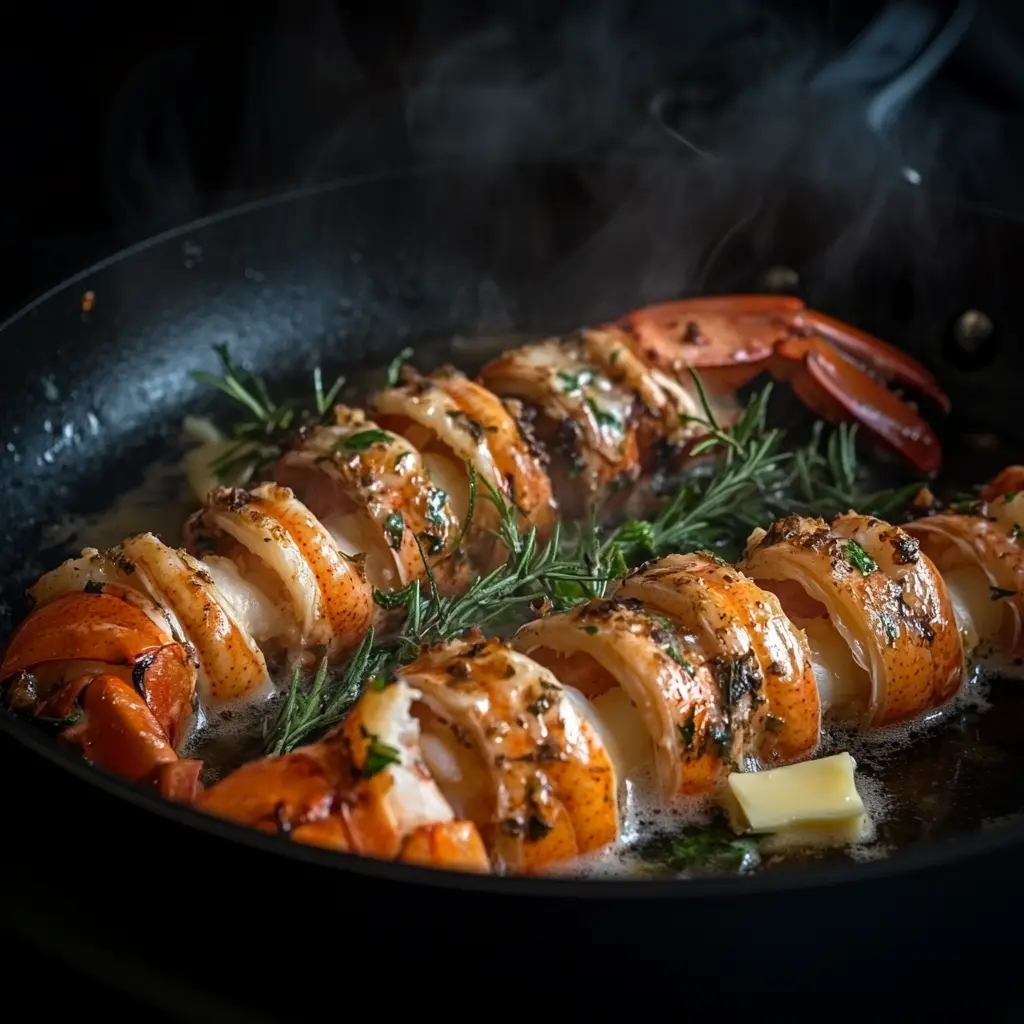
Popular Cooking Methods
Langoustine tails are versatile and adapt well to various cooking techniques. Each method highlights their sweet, tender flavor differently. Here’s an overview of the most popular methods:
- Grilling: Perfect for achieving a smoky char, grilling enhances the natural sweetness of langoustines. Brush the tails with olive oil, season with salt and pepper, and grill them shell-side down for 2-3 minutes per side.
- Boiling: A simple and quick method, boiling preserves the delicate flavor. Submerge the tails in salted boiling water for 3-5 minutes, depending on their size. Remove and serve with melted butter or a squeeze of lemon.
- Sautéing: Sautéing in a hot skillet with garlic, butter, and herbs creates a rich, aromatic dish. Cook the tails for 2-3 minutes on each side until opaque and golden.
- Steaming: Retain moisture and flavor by steaming the tails for 4-6 minutes. Add aromatics like bay leaves or lemon slices to the steaming water for an extra flavor boost.
- Baking: For a sophisticated presentation, bake the tails with a crust of breadcrumbs, garlic, and parmesan cheese. Bake at 375°F (190°C) for 10-12 minutes until golden brown.
Pairing with Other Ingredients
Langoustine tails pair beautifully with a variety of flavors, both bold and subtle. Here are some pairing ideas:
- Citrus: Lemon and orange zest bring out the freshness of the seafood.
- Herbs: Dill, parsley, and thyme complement the sweetness of the tails.
- Spices: Paprika, cayenne, and saffron add depth and complexity to dishes.
- Starch: Serve with pasta, risotto, or crusty bread to create a filling meal.
- Vegetables: Asparagus, zucchini, or cherry tomatoes make for a colorful and flavorful accompaniment.
Cooking Tips for Perfect Langoustines
To ensure your langoustine tails turn out perfectly every time, keep these tips in mind:
- Avoid Overcooking: Langoustines cook quickly and become rubbery if overdone. Remove them from heat as soon as they turn opaque and firm.
- Use High Heat: For grilling or sautéing, high heat ensures a quick sear and locks in moisture.
- Enhance with Butter: A butter glaze adds richness and enhances the natural flavor.
With these cooking methods and tips, you’ll achieve restaurant-quality langoustine dishes at home.
Langoustine Tails Recipes
Classic Butter-Garlic Langoustine Tails
Ingredients:
- 8 langoustine tails, cleaned
- 4 tablespoons unsalted butter
- 3 cloves garlic, minced
- 2 tablespoons fresh parsley, chopped
- Juice of half a lemon
- Salt and pepper to taste
Instructions:
- Melt the butter in a large skillet over medium heat.
- Add the minced garlic and sauté until fragrant, about 1 minute.
- Place the langoustine tails in the skillet, flesh-side down. Cook for 2-3 minutes until slightly golden.
- Flip the tails and cook shell-side down for another 2 minutes.
- Drizzle with lemon juice, sprinkle with parsley, and season with salt and pepper.
- Serve hot with a side of crusty bread or steamed vegetables.
Langoustine Pasta
Ingredients:
- 6-8 langoustine tails, cleaned
- 300 grams of spaghetti or linguine
- 2 tablespoons olive oil
- 3 cloves garlic, thinly sliced
- 1/4 cup dry white wine
- 1 cup cherry tomatoes, halved
- Fresh basil leaves for garnish
Instructions:
- Cook the pasta according to package instructions. Reserve 1/2 cup of pasta water.
- In a large skillet, heat the olive oil over medium heat. Add garlic and sauté until lightly golden.
- Add the langoustine tails and cook for 2-3 minutes on each side. Remove from the skillet and set aside.
- Pour in the white wine, scraping up any bits from the bottom of the skillet. Add cherry tomatoes and cook until softened.
- Return the langoustine tails to the skillet and toss with the pasta, reserved pasta water, and basil leaves.
- Serve immediately with a sprinkle of grated Parmesan cheese.
Langoustine Risotto
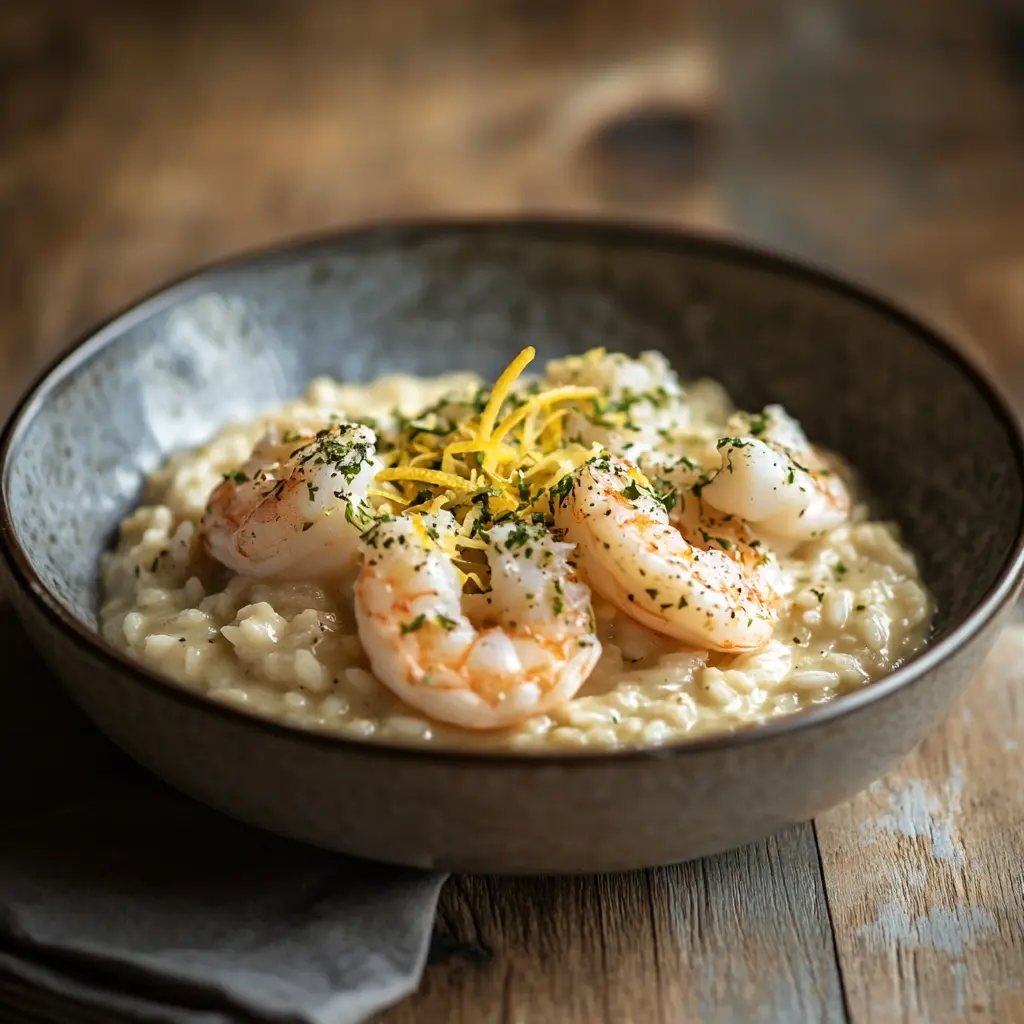
Ingredients:
- 6 langoustine tails, cleaned
- 1 cup Arborio rice
- 4 cups seafood or chicken stock, kept warm
- 2 tablespoons olive oil
- 1 small onion, finely chopped
- 1/2 cup dry white wine
- 1/4 cup grated Parmesan cheese
- Zest of one lemon
Instructions:
- Heat olive oil in a large pot over medium heat. Sauté onion until translucent.
- Add the rice and toast it lightly for 2 minutes.
- Pour in the white wine, stirring constantly until absorbed.
- Add the stock one ladle at a time, stirring frequently, and allow each ladle to be absorbed before adding more.
- Meanwhile, sauté the langoustine tails in a separate skillet for 2-3 minutes per side. Set aside.
- Once the rice is creamy and cooked, stir in Parmesan cheese, lemon zest, and langoustine tails. Serve hot.
These recipes showcase the versatility of langoustine tails, making them perfect for a variety of occasions.
Health Benefits of Langoustine Tails
High Protein Content
Langoustine tails are a rich source of high-quality protein, essential for building and repairing tissues in the body. With over 20 grams of protein per 100 grams of cooked langoustine, they provide a lean, satisfying option for those aiming to meet their daily protein requirements.
Protein not only supports muscle growth but also promotes a feeling of fullness, making langoustine tails an excellent choice for those managing their weight.
Omega-3 Fatty Acids
Langoustines are a notable source of omega-3 fatty acids, which are vital for heart and brain health. These healthy fats help lower triglyceride levels, reduce inflammation, and support cognitive function.
Regular consumption of omega-3-rich foods like langoustine tails is associated with:
- Improved cardiovascular health.
- Reduced risk of chronic diseases such as arthritis and diabetes.
- Enhanced mood and mental clarity.
Low-Calorie and Low-Fat Benefits
For those watching their calorie intake, langoustine tails are a guilt-free indulgence. With only about 100 calories and less than 2 grams of fat per 100 grams, they offer a nutrient-dense option that doesn’t compromise on flavor.
Their low-fat content makes them suitable for heart-healthy diets, while the natural sweetness of the meat allows for minimal seasoning and added fats during cooking.
Rich in Essential Vitamins and Minerals
Langoustine tails are packed with vital vitamins and minerals that contribute to overall well-being:
- Vitamin B12: Essential for nerve function and red blood cell production.
- Selenium: An antioxidant that supports immune health and thyroid function.
- Zinc: Promotes skin health and boosts immunity.
Including langoustine tails in your diet not only satisfies your taste buds but also provides significant health benefits that contribute to a balanced and nutritious lifestyle.
Langoustine Tails in Global Cuisine
Popularity in Mediterranean Cuisine
Langoustine tails are a staple in Mediterranean kitchens, celebrated for their delicate flavor and versatility. Countries like Italy, Spain, and Greece incorporate langoustines into traditional dishes such as:
- Fideuà: A Spanish seafood paella-style dish made with noodles instead of rice.
- Scampi alla Griglia: Grilled langoustine tails, often served with lemon and olive oil.
- Spaghetti ai Langoustini: An Italian classic featuring langoustines in a light tomato and garlic sauce over pasta.
The Mediterranean approach emphasizes fresh, high-quality ingredients to complement the natural sweetness of the langoustines.
Langoustines in French and Italian Dishes
In French cuisine, langoustines are often featured in haute cuisine, paired with rich sauces or baked into pastries. Iconic dishes include:
- Langoustine Bisque: A creamy, aromatic soup made from langoustine shells and meat.
- Vol-au-Vent aux Langoustines: Puff pastry filled with a decadent langoustine cream mixture.
Italian chefs showcase langoustine tails in risottos, seafood platters, and as the centerpiece in holiday feasts. The emphasis on seasonal ingredients and elegant presentation makes these dishes stand out.
Asian Inspirations
Langoustine tails have also made their way into Asian-inspired recipes, where bold flavors take center stage. Common preparations include:
- Stir-Fries: Langoustines are sautéed with soy sauce, ginger, garlic, and vegetables.
- Tempura: Lightly battered and fried langoustine tails served with dipping sauces.
- Curry: Langoustine meat simmered in coconut milk-based curries infused with spices like turmeric, coriander, and chili.
These dishes highlight the adaptability of langoustine tails, proving they can shine in any culinary tradition.
Pairing Langoustines with Regional Ingredients
Langoustines adapt well to regional ingredients, creating unique flavor combinations:
- Northern Europe: Dill, mustard sauce, and new potatoes.
- Southeast Asia: Lemongrass, lime leaves, and chili peppers.
- The Americas: Sweet corn, avocado, and cilantro.
Exploring global recipes is an exciting way to appreciate the universal appeal of langoustine tails.
FAQs
How are langoustines different from lobsters?
Langoustines, also known as Norway lobsters, are smaller and more delicate than traditional lobsters. While lobsters have a firmer texture and stronger flavor, langoustines boast a sweeter and more tender meat. Additionally, lobsters are larger and primarily sourced from North America, whereas langoustines are native to the North Atlantic and Mediterranean waters.
Can you eat raw langoustine tails?
Langoustine tails can be eaten raw when they are extremely fresh and properly handled. Raw langoustine meat, often featured in sushi or sashimi, has a sweet, creamy texture. However, it is crucial to source your seafood from a trusted supplier and ensure that it is sushi-grade to minimize health risks.
How long do langoustine tails last?
Fresh langoustine tails should be cooked within 24-48 hours of purchase. If frozen, they can last up to three months when stored at a constant temperature of -18°C (0°F) or below. Always thaw frozen langoustines in the refrigerator overnight before cooking to maintain their quality.
Are langoustines sustainable?
Sustainability depends on the fishing practices and region of harvest. Look for certifications like the Marine Stewardship Council (MSC) label, which ensures that the langoustines were caught using eco-friendly methods. Opting for sustainably sourced langoustines helps preserve marine ecosystems.
What is the best way to cook langoustine tails?
The best cooking method depends on personal preference and the dish you’re preparing. Grilling enhances their natural sweetness with a smoky flavor, while steaming or boiling preserves their tender texture. For a rich, buttery flavor, sautéing with garlic and herbs is a popular choice.
Can you substitute langoustines with other seafood?
Yes, langoustines can be substituted with shrimp, prawns, or even lobster in recipes, though the flavor and texture will differ slightly. Langoustines offer a sweeter and more refined taste compared to their substitutes, so adjustments to seasonings may be needed to achieve similar results.
Conclusion
Langoustine tails are a true delicacy, offering a unique combination of sweetness, tenderness, and versatility. From their origins in the cold waters of the North Atlantic to their starring role in gourmet dishes worldwide, langoustines hold a special place in the culinary world.
Whether you’re savoring them in a Mediterranean pasta, a creamy risotto, or a simple butter-garlic preparation, langoustine tails are sure to elevate any meal. Their health benefits, including high protein content, omega-3 fatty acids, and essential vitamins, make them a nutritious choice for seafood lovers.
By understanding how to select, prepare, and cook langoustine tails, you can bring the elegance of this seafood delicacy to your table. Experiment with global flavors, pair them with fine wine, and enjoy the journey of exploring all that langoustine tails have to offer.

